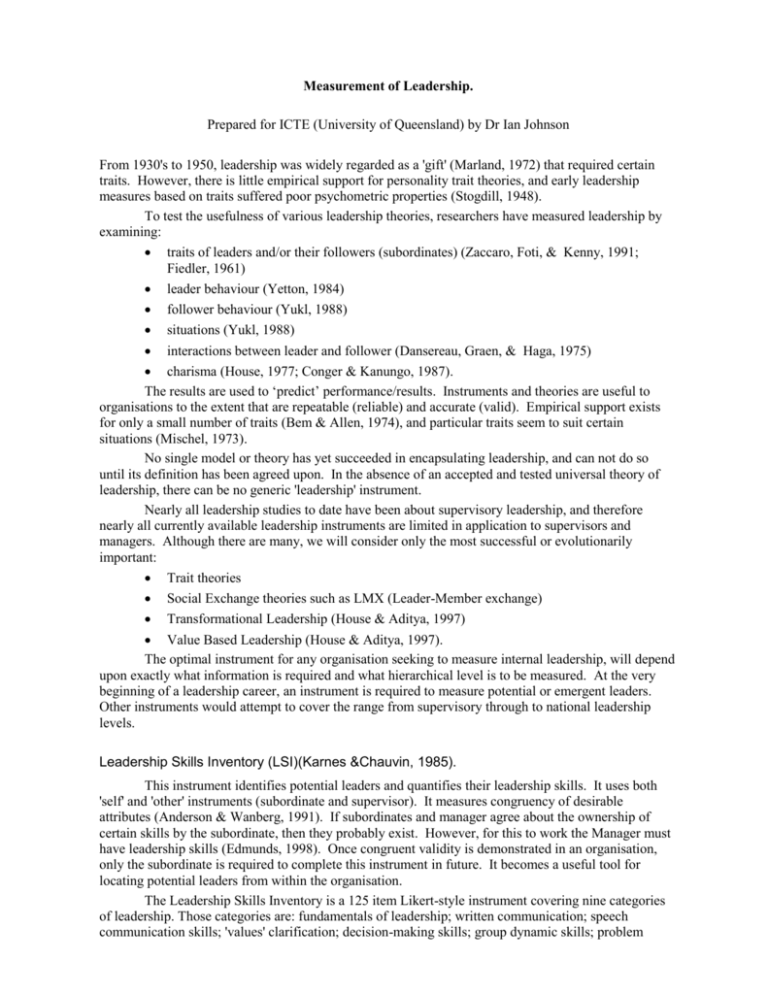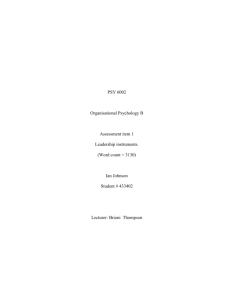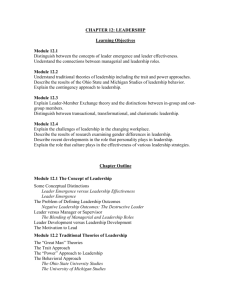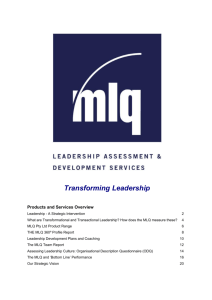Leadership Measurement - University of Queensland
advertisement

Measurement of Leadership. Prepared for ICTE (University of Queensland) by Dr Ian Johnson From 1930's to 1950, leadership was widely regarded as a 'gift' (Marland, 1972) that required certain traits. However, there is little empirical support for personality trait theories, and early leadership measures based on traits suffered poor psychometric properties (Stogdill, 1948). To test the usefulness of various leadership theories, researchers have measured leadership by examining: traits of leaders and/or their followers (subordinates) (Zaccaro, Foti, & Kenny, 1991; Fiedler, 1961) leader behaviour (Yetton, 1984) follower behaviour (Yukl, 1988) situations (Yukl, 1988) interactions between leader and follower (Dansereau, Graen, & Haga, 1975) charisma (House, 1977; Conger & Kanungo, 1987). The results are used to ‘predict’ performance/results. Instruments and theories are useful to organisations to the extent that are repeatable (reliable) and accurate (valid). Empirical support exists for only a small number of traits (Bem & Allen, 1974), and particular traits seem to suit certain situations (Mischel, 1973). No single model or theory has yet succeeded in encapsulating leadership, and can not do so until its definition has been agreed upon. In the absence of an accepted and tested universal theory of leadership, there can be no generic 'leadership' instrument. Nearly all leadership studies to date have been about supervisory leadership, and therefore nearly all currently available leadership instruments are limited in application to supervisors and managers. Although there are many, we will consider only the most successful or evolutionarily important: Trait theories Social Exchange theories such as LMX (Leader-Member exchange) Transformational Leadership (House & Aditya, 1997) Value Based Leadership (House & Aditya, 1997). The optimal instrument for any organisation seeking to measure internal leadership, will depend upon exactly what information is required and what hierarchical level is to be measured. At the very beginning of a leadership career, an instrument is required to measure potential or emergent leaders. Other instruments would attempt to cover the range from supervisory through to national leadership levels. Leadership Skills Inventory (LSI)(Karnes &Chauvin, 1985). This instrument identifies potential leaders and quantifies their leadership skills. It uses both 'self' and 'other' instruments (subordinate and supervisor). It measures congruency of desirable attributes (Anderson & Wanberg, 1991). If subordinates and manager agree about the ownership of certain skills by the subordinate, then they probably exist. However, for this to work the Manager must have leadership skills (Edmunds, 1998). Once congruent validity is demonstrated in an organisation, only the subordinate is required to complete this instrument in future. It becomes a useful tool for locating potential leaders from within the organisation. The Leadership Skills Inventory is a 125 item Likert-style instrument covering nine categories of leadership. Those categories are: fundamentals of leadership; written communication; speech communication skills; 'values' clarification; decision-making skills; group dynamic skills; problem solving skills; personal development skills, and planning skills. This instrument exposes the leadership strengths and weaknesses of a person, enabling clear training plans to be tailor-made for that individual. A supporting study of the instrument provides empirical support of concurrent, content, and construct validity (Edmunds, 1998). Concurrent validity was supported by correlation (r=.34, p<.01) between LSI score and observed leadership behaviour. Content validity was gained through expert jury agreement on content applicability of each question. Finally, a single factor was evenly and heavily loaded by each component (.636 to .876), supporting the construct validity, but not supporting the nine categories as separate components. The categories had much in common, with correlations between them ranging from r=.295 to .761, p<.01. The authors recommend that this instrument be used to guide developmental studies rather than as a basis for selecting from amongst potential leaders. Comment: This is to test members of a group to predict emergent leadership or to assign group leadership, or to monitor the effectiveness of leadership training. Leader member exchange (LMX-7) LMX theory is describes the dyadic relationship between an individual member and his or her supervisor, and describes reciprocal fulfillment of expectations (Graen et al., 1982). An important ingredient of the dyadic theory is the differentiated relationships yielding different qualities of exchange, in turn creating 'in' groups and 'out' groups of subordinates (Dansereau et al., 1975). LMX theory maintains that a work group should not be considered a single entity (Dansereau et al., 1975). Instead, it considers the relationships between leader and each group member as being a socially influencing behaviour of 'leadership' (Bhal & Ansari, 1996). LMX has been shown to positively relate to performance and satisfaction (Graen et al., 1986), locus of control and time-based pressure (Kinicki & Vecchio, 1994), delegation (Schriesheim et al., 1998), job attitudes and performance evaluations (Dienesch & Liden, 1986), and commitment and citizenship behaviour. LMX relates negatively to turnover (Graen et al., 1982)(good for the organisation) and performance (Vecchio & Gobdel, 1984)(bad for the organisation). Literature showed more studies with positive LMX-performance relationships than negative, but there was considerable variation. An explanation is offered by way of conversation quality of the relationship (Johnson, 2003). The LMX-7 instrument contains 7 items that examine the quality of exchange between leader and subordinate, and is completed by the subordinates of the supervisor/manager/leader. There is, however, considerable literature using the 7-item LMX measure from (Scandura & Graen, 1984), with most users reporting high alphas such as .91 (Klein & Kim, 1998), .86 (Scandura & Schriesheim, 1994) and .9 (Wayne et al., 1997). The LMX7 instrument can be used to examine the quality of social relationships perceived by subordinates to exist between themselves and their immediate leader. The testing of the instrument has been confined to organisational settings and is aimed at middle to lower management. Comment: The LMX seems more useful in hierarchical organisation with managers and supervisors, rather than organisations with a flat structure. LMX does not apply at executive level because high levels do not have the same co-worker/superior social support relationships. LMX also may not suit excessively high stress environments if there is a tendency for 'directing' behaviours to replace 'social influence' behaviours by supervisors under stress. (Staw et al., 1981) report that decisions made under stressful circumstances are, unlike LMX behaviour, likely to exhibit symptoms rigidity of response. Multifactor leadership questionnaire (MLQ) (Bass & Avolio, 1985) Charismatic leadership theory (House, 1977) regards charismatic leaders as exceptionally self-confident, strongly motivated to influence, and with strong convictions of the morality of their beliefs. This theory applies to all levels of leadership within or external to organisations. It has been supported in a wide range of situations (Yukl, 1993). Over the same general period that charismatic theory has been developed, others such as transformational leadership (Bass & Avolio, 1985), attributional theory of leadership (Conger & Kanungo, 1987) and the value based leadership theory (House & Aditya, 1997) also emerged. The interest in these theories result from their generalisability across levels, genders, and 1 cultures (summarised in House & Aditya, 1997), and the high level of follower commitment and performance, especially when the organisation is under stress (Adamson, 1997) However, these theories have been critisised for limitations regarding measures of effects on followers, the single lumping of charismatic behaviours as a single undifferentiated syndrome, and inattention to important group characteristics (Shamir et al., 1998). There is scant attention to the social implications of leadership. The instrument used most frequently for this form of leadership is the MLQ (Bass & Avolio, 1985). While there are several revisions of the MLQ, they all comprise subscales and use a 5 point Likert type scale. MLQ looks at traits and at the effects of leaders on followers, all measured through the eyes of the followers (Shamir et al., 1998). The MLQ attempts to measure transactional, transformational, and laissez-faire leadership in a leader's performance, where transactional and transformational leadership styles each comprise several sub-scale dimensions and accompanying behaviours (Bass & Avolio, 1990). The three-factor model of this leadership theory remains a valid concept for training purposes, but the high correlation suggests caution when interpreting sub-scales. More recently, the MLQ is being used to not just measure the transformational leadership, but the ratio of the three styles as perceived by the followers. Comment: The MLQ is broadly applicable to a wide range of organisational, political, or other leadership situations, and at any level where there is responsibility to influence the actions of others. It can apply to managers, supervisors, or CEO's, and can indicate the extent of transactional, transformational, or laissez-faire leadership experienced by followers. It is probably wasted in a strict rule-driven bureaucratic environment where there is little opportunity for doing things differently or for personal growth. LPI Leadership Practices Inventory (Posner & Kouzes, 1993). This instrument grew not from a model, but from a desire to measure actual successful organisational leadership behaviours, and to shift away from psychological characteristics (Posner & Kouzes, 1993). It moved from 'what they are like' to 'what do they do'. Surveys and interviews of over 1,100 leaders about their best personal leadership experiences yielded data about the ideal behaviours of leaders. A process of testing on another 2,100 managers and narrowing down the data, resulted in two 5 point Likert-style instrument of 30 questions covering 5 leadership practices. The 5 practices are: challenging the process, inspiring a shared vision, enabling others to act, modeling the way, and encouraging the heart. One of the instruments (LPI Observer) is for subordinates to report on their manager. The other (LPI Self), is for the manager to self-report. Reliability and validity tests involved another 2,876 managers and their subordinates, representing both genders, and 4 foreign countries. Internal consistency of the 5 sub-scales ranged from .70 to .91, with test-retest reliability .93 and above. Further psychometric investigation (Posner & Kouzes, 1993) using data from 5,298 managers and 30,913 subordinates confirmed 5 factors corresponding to the hypothesised dimensions. The authors also reported small gender differences with females reportedly engaging more in modeling and encouraging. Female subordinates reported their managers as more challenging and higher modeling, regardless of manager gender, and LPI Self scores tend to be higher than LPI Observer. LPI scores have been shown to relate to organisational effectiveness, work group vitality, job satisfaction and organisational commitment (Posner & Kouzes, 1993). LPI has differentiated between transactional and transformational styles (Fields & Herold, 1997), where challenging the process and inspiring a shared vision related to transformational leadership, while enabling others related to transactional leadership. Encouraging the heart and modeling the way related to both styles. Comment: The LPI can quantify the five sub-scale qualities of leadership practice and also distinguish between transformational and transactional leadership style. Such a comprehensive range of information from a modest 30-item instrument may be useful to assess adjustments during periods of organisational change, regardless of cultures or genders involved. This instrument is restricted to intraorganisational leadership. 2 Summary and recommendations Until the time that there is a comprehensive definition of leadership and a companion instrument, the instruments that enjoy high and consistent empirical or replicated support are to be preferred over others, no matter how convincing the theory or argument in their favour. All instruments mentioned in this report are supported, but use of any instrument must be on condition that it is appropriate to the intended application. References Adamson, T. (1997). An examination of gender differences in ideal leadership style using the Multifactor Leadership Questionnaire. Unpublished doctoral dissertation, Griffith University, Griffith. Anderson, S., & Wanberg, K. (1991). A congruent validity model of emergent leadership in groups. Small Group Research, 22(3). Bass, B., & Avolio, B. (1985). The multifactor leadership questionnaire. Palo Alto: Consulting Psychologists Press. Bass, B., & Avolio, B. (1990). The implications of transactional and transformational leadership for individual, team, and organizational development. Research in Organizational Change and Development, 4 , 231-272. Behling, O., & McFillen, J. (1996). A syncratical model of charasmatic / transformational leadership. Group and Organizational Management, 21(2), 163. Bem, D., & Allen, A. (1974). On predicting some of the people some of the time: The search for cross-situational consistencies in behaviour. Psychological Review, 81, 506-520. Bhal, K., & Ansari, M. (1996). Measuring quality of interaction between leaders and members. Journal of Applied Social Science, 26(11), 945. Bryman, A. (1993). Charismatic leadsership in business organisations: Some neglected issues. Leadership Quarterly, 4(3/4), 280-304. Carless, S. (1998). Assessing the discriminant validity of transformational leader behavoir as measured by the MLQ. Journal of Occupational and Organizational Psychology, 71(4), 353-358. Conger, J., & Kanungo, R. (1987). Toward a behavioural theory of charasmatic leadership in organisational settings. Academy of Management Journal, 12, 637-647. Dansereau, F., Graen, G., & Haga, W. (1975). A vertical diad linkage approach to leadership within formal organisations. Organizational Behaviour and Hmuan Performance, 13, 46-78. Den Hartog, D., Van Muijen, J., & Koopman, P. (1997). Transactional versus transformational leadership: An analysis of the MLQ. Journal of Occupational and Organisational Psychology, 70(1), 19(16). Dienesch, R., & Liden, R. (1986). Leader-exchange exchange model of leadership: A critique and further development. Academy of Management Journal, 11, 618-634. Edmunds, A. (1998). Content, concurrent and construct validity of the leadership skills inventory. Roeper Review, 20(4), 281-285. Edwards, J., Rode, L., & Ayman, R. (1990). The construct validity of scales from four leadership questionnaires. The Journal of General Psychiatry, 116(2), 171-181. Fiedler, F. (1961). Leadership and leadership effectiveness traits: A reconceptualisation of the leadership trait problem. D. A. P. Porter (Ed), Studies in Organisational Behaviour and Management . Pennsylvania: International Textbook. Fields, D., & Herold, D. (1997). Using the Leadership Practices Inventory to measure transformational and transactional leadership. Educational and Psychological Measurement, 57(4), 569-580. Graen, G., Novak, M., & Sommerkamp, P. (1982). The effects of leader-member exchange and job design on productivity and job satisfaction: Testing a dual attachment model. Organizational Behavior and Human Performance, 30, 109-131. Graen, G., Scandura, T., & Graen, M. (1986). A field experiment test of the moderating effects of growth need on productivity. Journal of Applied Psychology, 71, 484491. House, R. (1971). A path goal theory of leader effectiveness. Administrative Quarterly, 16, 321-338. House, R. (1977). A 1976 theory of charasmatic leadership. J. L. L. Hunt (Eds), Leadership: The cutting edge . Illinois: Illinois University Press. House, R. (1996). Path-goal theory of leadership: Lessons, legacy and a reformulated theory. The Leadership Quarterly, 7(3), 23-58. House, R., & Aditya, R. (1997). The social scientific study of leadership: quo vadis? Journal of Management, 23(3), 409-474. Karnes, F., Deason, D., & D'ilio, V. (1993). Leadership skills and self-actualization of school-age children. Psychological Reports, 73(3), 861. Kinicki, A., & Vecchio, R. (1994). Influences on the quality of supervisor-suborinate relations: The role of timepressure, organisational commitment, and locus of control. Journal of Organizational Behavior, 15, 75-82. Klein, H., & Kim, J. (1998). A field study of the influence of situational constraints, leader-member exchange, and goal commitment on performance. Academy of Management Journal, 41(1), 88-95. Liden, R., & Maslyn, J. (1993). LMX-MDM: Scale development for a multidimensional measure of leadermember exchange. National meeting of Academy of Management Chicago: University of Illinois. Mischel, W. (1973). Towards a cognitive social learning reconceptualisation of personality. Psychological Review, 80, 252-283. Peters, L., Hartke, D., & Pohlmann, J. (1985). Fiedler's contingency theory of leadership: An application of meta-analysis procedures of Schmidt and Hunter. Psychological Bulletin, March, 274-285. Posner, B., & Kouzes, J. (1993). Psychometric properties of 3 the Leadership Practices Inventory - updated. Educational and Psychological Measurement, 53, 191198. Posner, B., & Kouzes, J. (1994). An extenstion of the Leadership Practices Inventory to indovidual contributors. Educational and Psychological Measurement, 54(4), 959-966. Rice, R. (1978). Construct validity of least preferred coworker score. Psychological Bulletin, 85, 1199-1237. Robbins, S., Waters-marsh, T., Cacioppe, R., & Millett, B. (1994). Organisational behaviour. Australia: Prentice Hall. Scandura, C., & Schriesheim, C. (1994). Leader-member exchange and supervisor career mentoring as complimentary constructs in leadership research. Academy of Management Journal, 37(6), 1588(15). Scandura, T., & Graen, G. (1984). Moderating effects of initital leader-member exchange status on the effects of leadership intervention. Journal of Applied Psychology, 69, 428-436. Schriesheim, C., Neider, L., & Scandura, T. (1998). Delegation and leader-member exchange: main effects, moderators, and measurement issues. Academy of Management Journal, 41(3), 298. Schriesheim, C., Scandura, T., Eisenbach, R., & Neider, L. (1992). Validation of a new leader-member exchange scale (LMX-6) using hierarchically-nested maximum likelihood confirmatory factor analysis. Educational and Psychological Measurement., 52, 983-992. Shamir, B., Zakay, E., Brenin, E., & Popper, M. (1998). Correlates of charasmatic leader behaviou in military units: subordinates' attitudes, unit of characteristics, and superiors' appraisals of leader performance. Academy of Management Journal, 41(4), 387-401. Sparrowe, R., & Liden, R. (1997). Process and structure in leader-member exchange. Academy of Management Review, 22(2), 522-552. Staw, B., Sandelands, L., & Dutton, J. (1981). Threatrigidity effects in organizational behavior: A multilevel analysis. Administrative Science Quarterly, 26, 501524. Stogdill, R. (1948). Personal factors associated with leadership: A survey of the literature. Journal of Psychology, 25, 35-71. Tracey, B., & Hinkin, T. (1998). Transformational leadership or effective managerial practices? Group & Organization Management, 23(3), 220-236. Vecchio, R., & Gobdel, B. (1984). The vertical dyad linkage model of leadership: Problems and prospects. Organizational Behavior and Human Performance, 34, 520. Wayne, S., Shore, L., & Linden, R. (1997). Perceived organizational support and leader-member exchange: A social exchange perspective. Academy of Management Journal, 40(1), 82-111. Yetton, P. (1984). Leadership and supervision. J. L. L. Hint (Eds), Leadership: The cutting edge . Illinois: Illinois University Press. Yukl, G. (1988). Managerial leadership: A review of theory and research. Journal of Management, 15(2), 251-289. Yukl, G. (1993). A retrospective on Robert House's 1976 theory of charismatic leadership and recent revisions. Leadership Quarterly, 4(3/4), 367-373. Zaccaro, S., Foti, R., & Kenny, D. (1991). Self-monitoring and trait-based variance in leadership: An investigation of leader flexibility across multiple group situations. Journal of Applied Psychology, 76, 308-315. In May, Japanese motor maker Minebea broke ground in Phnom Penh for a 5,000-worker plant. The company had at first considered Vietnam but rejected it because strikes had become increasingly common there. Workers are demanding better pay as the highest inflation in Asia hurts their purchasing power. Inflation quickened to a 29-month high of 19.78 percent in May Vietnam had 336 strikes in the first four months of 2011, according to its General Confederation of Labor: That's on course to beat the 2008 record of 762 The strikes have dented Vietnam's 25-year-old policy of offering foreign investors a stable workforce whose minimum wage, at $85 a month, is still half that of China. Vietnam's workers say they have to strike. At an industrial park in Hanoi, factory hand Le Kien scans job openings on a bulletin board, looking for better pay. He has just finished his shift at a plant that assembles cables used in Honda and Yamaha motorcycles. "The price of everything—food, gas, electricity—has gone up by more than my pay raise," says Kien, 24, whose monthly salary is equivalent to $87. "I can't even afford to start a family. I wouldn't have enough to buy milk for my baby." Of the hundreds of strikes that have taken place in Vietnam over the last few years, some 70% have occurred in private firms, many of whom brazenly violate the labour laws and force workers to work horrendously long hours in appalling conditions. Some 70% of the dramatically rising number of 1 industrial accidents, which killed 174 and injured 1300 in the first half of 2000, also occur in private firms, both foreign- or domestically-owned. 1











